

by Tim Gillespie
This month we are going to look at combining linear statements with chordings. Often times guitarists have problems combining chords with anything else. If you hands are busy holding down a chord, you might be hard pressed to free up a finger or two to hit accent notes. However with a little work you can easily start adding accent notes and linear runs in between chords. So let's take a look at chords and extensions.
So in order to do this my way, we need to pick a key and then look at some likely candidates for chords and scale pathways.


 So I pick the key of D major this time. The key of D major has two sharps
in it, C# and F# but we are not going to worry about that too much today.
It is worth noting that we are complicating an exact understanding, by
working in a key that has a few sharps. As far as the structures we will
use, it really doesn't matter at all.
So I pick the key of D major this time. The key of D major has two sharps
in it, C# and F# but we are not going to worry about that too much today.
It is worth noting that we are complicating an exact understanding, by
working in a key that has a few sharps. As far as the structures we will
use, it really doesn't matter at all.
So here is the signature of D major. This is what we will use as a framework. You can break it into two separate areas which we will use. The first and second position.
Notice we are only highlighting different notes in the examples to the right.
We are mainly going to work out of the first position D major area however we will go into the second position to mix things up a little.
Okay below is the basic progression we are going to work from. You can play these as slow or as fast as you like, but I think you will have the best results if you play a very slow progression and use the extra time to insert some linear streams of notes.
Sample Progression #1
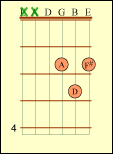


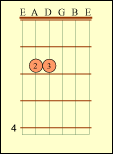


Sample Progression #2


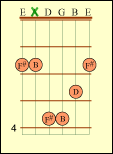



So now we need to take these chords apart and look at the ascent notes we can work with. Let's start with D major.
This is the standard D major chord, play the open D note with it. Now we can look for opportunities to throw in accent notes.
 The first thing I usually do is work in the outside, High E string notes.
These notes are pretty easy to throw in while you play the chord. You
can use you pinkie to play the G note while you strum the D chord and
you can lift up your second finger to let the open E note ring out.
The first thing I usually do is work in the outside, High E string notes.
These notes are pretty easy to throw in while you play the chord. You
can use you pinkie to play the G note while you strum the D chord and
you can lift up your second finger to let the open E note ring out.




 This
is the typical set of moves you see used when people strum the D major
chord. But you can also go farther down the scale and use some hammer
ons to mix in some other notes.
This
is the typical set of moves you see used when people strum the D major
chord. But you can also go farther down the scale and use some hammer
ons to mix in some other notes.
With this combination you are moving through the standard major chord, suspended 4th chord and suspended 2nd chord. This is a simple set of accent notes. So now we are going to stay in the same first position but we are going to try hammering some open string combinations.

 Use the open G note and hammer the A note. Then sound the open string
D note and then hammer the E note (on the D string). Hammering means to
sound the open string note, then quickly press your second finger on the
A or E note and then release it, which should cause the open string note
to sound again.
Use the open G note and hammer the A note. Then sound the open string
D note and then hammer the E note (on the D string). Hammering means to
sound the open string note, then quickly press your second finger on the
A or E note and then release it, which should cause the open string note
to sound again.
After you are comfortable with this, try hammering the C# note too. It can be slightly harder to mix in, because it is in the middle of the chord. That seems to add an extra complication at first.
Also remember you can work in a run that briefly uses these notes. This may have a tendency to sound a little linear, but if it is an accent notes you can blend it in pretty well.
So you have the ability to work either up the scale or down the scale. As you are playing with different combinations notice you may gravitate towards another chord in the progression.
 If you are hammering
the A and E notes, you are working towards the G chord. Since there are
a fair amount of open strings used in this situation, it can be quite
easy to hammer the A and E notes and then land on the G major chord.
If you are hammering
the A and E notes, you are working towards the G chord. Since there are
a fair amount of open strings used in this situation, it can be quite
easy to hammer the A and E notes and then land on the G major chord.
Remember we are using the chords in the key of D major, so they will all work with the D major scale. As you play these chords, you are using the convenient notes of the D major scale for accent notes. That is why all these diagrams are constructed from the D major scale.
So we have only played two chords in a six chord progression and look at all the opportunities to pull the direction of the progression we have encountered. If you have two guitarists, have one concentrate on the lead work, while the other one works up a nice progression.
Resources You Will Keep Forever!
Absolutely the definitive answer for understanding the guitar.
The Uncle Tim Series is sold into recording studios over the U.S. and are used by professional musicans and teachers everwhere.
If you are serious about guitar, these resources are indispensable.
Instead of wondering about everything, now you can know it all. And much easier than you might think. Pick up a copy today.
eBooks are delivered instantly!
 So now we are
working back towards the middle of the scale by moving to the A major
chord. Did you notice the same notes we were hammering are now going to
form the next chord. When you move back to this chord, you have an opportunity
to create a very strong sound. You can pounce on this chord and create
a sense of confidence.
So now we are
working back towards the middle of the scale by moving to the A major
chord. Did you notice the same notes we were hammering are now going to
form the next chord. When you move back to this chord, you have an opportunity
to create a very strong sound. You can pounce on this chord and create
a sense of confidence.
You can also create a situation where there is not as much variation in the progression because you are working the same notes too much. It can sound cluttered. In that case you would be working hard, but not getting all the creative benefits. So when you start to experiment with these types of extensions, be prepared to hear some strange combinations. As you continue to work through this type of exercise, your brain will also sort it out and focus on what you like. In order to know what you like, you have to play through some of this and decide for yourself. All that scale work will really pay off when you play this type of exercise.
Usually when I play through some examples using these chords, I insert a little pause between the A chord and the E minor chord. Also notice the next six chords uses a slightly different arrangement. I wanted to mix things up a bit and throw in a simple creative twist. You could examine some other combinations in this key and really polish up a few. From there you might hear an original song or two emerge. That skill may take a few weeks or months to develop, but it is not far away for anyone who experiments with this.
 If you have
thrown in accent notes for the chords before this one, it might be nice
to take a break here and just play an arpeggio. This way you get a little
break and you can set up the next accent moves. It reinforces the basic
sound of the chords together.
If you have
thrown in accent notes for the chords before this one, it might be nice
to take a break here and just play an arpeggio. This way you get a little
break and you can set up the next accent moves. It reinforces the basic
sound of the chords together.
This chord really sets up the return to tonic nicely. This is the third degree in the key of D major, it is the fourth chord in this progression and after you move through the key a little bit, a desire to return to tonic begins to emerge. To satisfy that urge, I am going to hit one more chord and then return to tonic and release some tension.

 For
the first progression I find myself usually playing the G chord by strumming
and then pouncing on the D chord to relieve tension.
For
the first progression I find myself usually playing the G chord by strumming
and then pouncing on the D chord to relieve tension.
However when I play the second progression I do not play the A chord at all, instead I sometimes hammer the A note then the C# note and move right to D major. It takes a while to work out the timing, but if you play the progression for 30 minutes, you will work out much of this. You can slow this way down at first.
That is the basic progression of notes. There are opportunities for accent notes and small runs with every chord.
When you start a run off a chord, it can be hard to hit the right note to start the run. If you miss the first note, the run never happens. So examine your tendencies as you initiate movement. Make sure you know exactly where to strike the string. This was a problem for me for a while.
If you are ambitious, you can easily substitute some other chord forms and change the whole feeling.









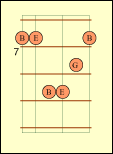



Chord And Scale Runs
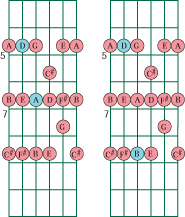
 For accent notes we are going to think a little different here. Notice all
of these chords have a fifth (power chord) inside the chord.
For accent notes we are going to think a little different here. Notice all
of these chords have a fifth (power chord) inside the chord.
Notice that D and A notes form a fifth. This is the same power chord that is used so extensively in Rock. Also The D and B combination (a sixth) is used with the fifth. We will go into this when we look at the twelve barre blues next month.

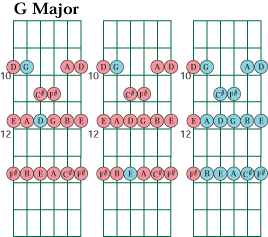 You
can do this for the other chords here too. To the left are the fifth substitutions
for G major.
You
can do this for the other chords here too. To the left are the fifth substitutions
for G major.
The first example is the fifth. This is the actual power chord. The second example is the sixth. The G and E notes.
The third example is the typical run you might use if you had to rip into a solo or accent run. You can use any scale run in the key of D major.

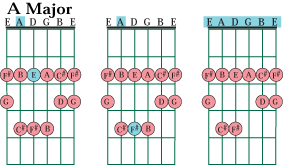 This
is a very helpful fifth to play. It uses the open strings and can be useful
for slow rock and roll songs.
This
is a very helpful fifth to play. It uses the open strings and can be useful
for slow rock and roll songs.
It is based on the A major chord and you can use the open string D scale to base a run off of in this instance.

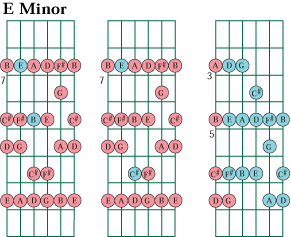 By
substituting this chord not only do we radically change the sound of the
chord but also the position. We are now working in the second position
and we are ready to climb much higher.
By
substituting this chord not only do we radically change the sound of the
chord but also the position. We are now working in the second position
and we are ready to climb much higher.
The scale pattern shown in blue is a well known one and easily allows for a linear stream of music. You can hold down any row of notes as a barre and hammer the other notes if you are strong enough. You could even incorporate the fifth chord in as a part of the hammer ons.

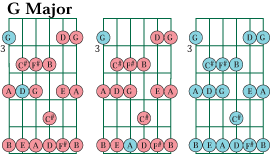 The
G major chord could use the open string D scale or this one. This is convenient
because the chord is right there and easy to form should you choose to
go back to it.
The
G major chord could use the open string D scale or this one. This is convenient
because the chord is right there and easy to form should you choose to
go back to it.
These types of runs are more suited to two players but you can easily make up exercises that allow you to play both parts. This is not an easy thing to master and it might take several weeks before you start to really play these parts with control. The moves and sounds in this type of approach are unlimited. You need to be familiar enough with them so that your creativity is what you focus on and not how to hit the chord right. That will take some practice to execute correctly.
Different Scale Signatures

 There
are a multitude of things you can do with these substitutions. If two
people are playing the same progression, one person can be pounding out
these chords, while the other runs leads over it. This particular example
can use diatonic and pentatonic leads over it. Just use D major pentatonic.
There
are a multitude of things you can do with these substitutions. If two
people are playing the same progression, one person can be pounding out
these chords, while the other runs leads over it. This particular example
can use diatonic and pentatonic leads over it. Just use D major pentatonic.
I suggest you work out of the diatonic first. This is the scale that ties all this together. The chords are all carved out of this scale and you can easily work up the scale to climb higher in the registers (octaves).
When the chords climb higher, it can be nice to move down to the open string register. And when the chords are in the open string position, it is also nice to throw in a lead from the higher registers. This way you are covering more than one octave and this will introduce more interesting combinations.
It also takes away from the cluttered effect of playing too many notes in one octave.
So now we have taken a look at chord and scale combinations for the key of D. But that is not all there is to chose from. There are many chords in between the ones we have covered. This is an excellent time to talk about triad cascades.
Triad cascades map out every possibility for chord construction in any given area. You can use the mapping as a palette from which to choose just the right chord. If you use all three common inversions, you will have plenty of opportunities to choose the exact right chord. You do not have to memorize cascades. It is certainly a great idea to do so, but you can just examine the different cascades and cherry pick the chords you are interested in. That may spark your interest and expand your different uses for these flexible and versatile chords. Here is a simple mapping of first and second inversion triads for D major for all strings. There are more.
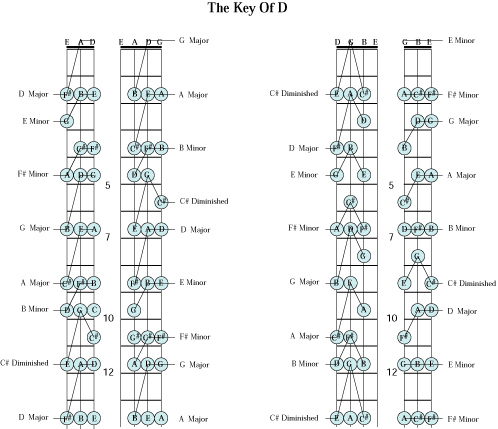
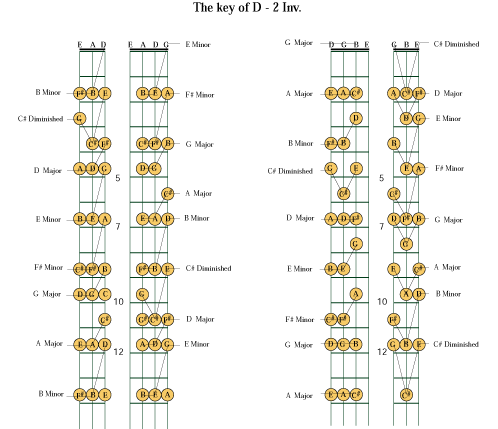
Parting Notes:
This exercise asks you to experiment with different chords, scales and notes that will tie it all together.
What started out as an exercise in accent notes has developed to a full blown basic examination of the key of D major.
Now it is just a case of determining how much detail you want. We get to work out of different parts of the fretboard and mix all sorts of interesting combinations.
This should open up some new avenues for creativity if you try out some different combinations and allow for some blind experimentation. This will give your mind a chance to sample some independent thoughts and travel down some unique paths. You never know what you will find, but one thing is for sure. If you take the time to play around and pull some sound out, you will generate some original progressions.
If you continue to attempt this, you will soon find some of the pathways familiar and friendly. Your fingers will soon begin to find favorite combinations as well as some you do not like. When you hear things you do not like, take a look at what you don't like. This will help you to recognize when you are going in that direction and then you can take steps to change it into something you do like.
Continuing to practice scales and triads independently will greatly facilitate this type of free form practice. When you build up strength in your fingers, you will create bolder sounds. You will sound more confident too.
One last thing to contemplate. We could have used Jazz chords to mix things up just as easy as we used power chords. Jazz chords will start with seventh chords and alterations using the second octave. They are more sophisticated and more complex to sort out so I stuck to an easier example. But for the guitarist that wants to work this hard stuff, you will find a rich and very rewarding palette for construction.
All of this will tie directly to what we discus in the special edition of Uncle Tim's Newsletter. This is the detailed approach to the information, next time we will look at the very biggest of pictures!